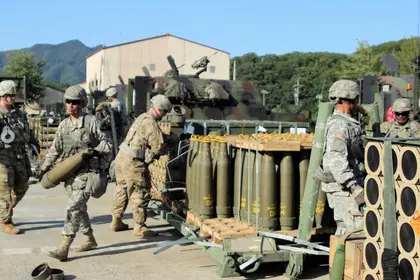The US announced on Friday it will provide cluster munitions to Ukraine for the first time, a highly significant and controversial decision aimed to boost Kyiv's forces in their summer offensive against invading Russian troops.
The move drew sharp criticism from rights groups due to the danger unexploded bomblets pose, but Washington said it has received assurances from Kyiv that it would minimize risk to civilians, including by not using the munitions in populated areas.
JOIN US ON TELEGRAM
Follow our coverage of the war on the @Kyivpost_official.
Why are these weapons needed?
President Joe Biden told CNN that the decision to provide the munitions was "very difficult," but that Ukrainian forces were "running out of ammunition."
"They either have the weapons to stop the Russians now – keep them from stopping the Ukrainian offensive through these areas – or they don't. And I think they needed them," he said.
US National Security Advisor Jake Sullivan explained the decision by saying there is "a massive risk of civilian harm if Russian troops and tanks roll over Ukrainian positions and take more Ukrainian territory and subjugate more Ukrainian civilians because Ukraine does not have enough artillery."
Referring to the Ukrainian counteroffensive, US Undersecretary of Defense Colin Kahl said "it's been hard sledding, because the Russians had... six months to dig in.”
He added: “And so those defensive belts that the Russians have put in place in the east and in the south are hard – they'd be hard for any military to punch through."

Ukraine Says Six Diplomatic Missions Damaged by Russian Strike on Kyiv
"We want to make sure that the Ukrainians have sufficient artillery to keep them in the fight in the context of the current counteroffensive, and because things are going a little slower than some had hoped, there are very high expenditures of artillery."
Why are these weapons so significant?
Ukraine has long-suffered a shortage of artillery shells and the decision to send cluster munitions means vast numbers of shells that have been sat gathering dust and previously unavailable for use by the Armed Forces of Ukraine (AFU), can now be put into service.
The US last used cluster munitions widely during its 2003 invasion of Iraq. A Pentagon focus on counter-insurgency and precision strikes over the next two decades moved US weapons development priorities away from munitions designed to striking a large area, and towards precision-guided systems.
This left reserves of decades-old American cluster munitions, designed for a conventional war rather than the actual War Against Terrorism, without a mission.
Now operating hundreds of towed and self-propelled howitzers sent by allies, and somewhere between 800 and 1,500 of its own artillery systems, the AFU’s capacity to fire off artillery shells has far outstripped allies’ ability to feed the cannon.
In December 2022 US Secretary of Army Christine Wormuth said the entire American defense industry is capable of manufacturing about 14,000 medium caliber 155mm artillery shells a month.
Ukrainian military analysts estimate that the Ukrainian army fires off between 5,000 and 9,000 155mm shells a day, depending on fighting intensity.
Once implemented, the new US cluster weapons shipments for Ukraine will give AFU gunners potential access to somewhere between 3 and 5 million shells, rockets and aerial bombs designed to scatter explosive sub-munitions over an extended target area, before blowing up.
Critically for Ukraine, these stocks contain millions of two munitions Ukrainian gunners have learned to fire with devastating effect: NATO-standard 155mm artillery shells fired by systems like the French Caesar and Polish Krab howitzers, and 227mm artillery rockets fired by the US-made M270 and HIMARS launchers.
Assuming US political will to back Ukraine remains strong and that logistical chains bear the stress, Ukraine’s battle-tested howitzer and rocket artillery gunners could, once the Friday decision is implemented, fight battles against Russian forces with more ammo than targets for the first time in the war.
Why are these weapons so controversial?
Cluster munitions are shells, rockets and aerial bombs designed to scatter explosive sub-munitions over an extended target area, before blowing up.
Not all the bomblets will explode however, and cluster munitions’ typically have a 3-10 percent failure rate, sowing target areas with unexploded bomblets potentially still lethal for decades.
An international convention banning cluster munitions went into effect in 2008 and by 2023 a total 123 nations had promised neither to manufacture nor to maintain stocks of cluster munitions. Russia, Ukraine and the US are not signatories.
Human Rights Watch said that "transferring these weapons would inevitably cause long-term suffering for civilians and undermine the international opprobrium of their use opposes."
And Amnesty International said Biden's administration "must understand that any decision enabling the broader use of cluster bombs in this war will likely lead to one predictable outcome: the further death of civilians."
"Cluster munitions are an indiscriminate weapon that presents a grave threat to civilian lives, even long after a conflict has ended. Their transfer and use by any country under any circumstances is incompatible with international law," it added.
UN Secretary-General Antonio Guterres also opposed the move, with a spokesperson saying he "does not want there to be continued use of cluster munitions on the battlefield."
What is the US and Ukraine doing to address these concerns?
When announcing the decision, US National Security Advisor Jake Sullivan said Kyiv "has provided written assurances that it is going to use these in a very careful way," he said, noting that Ukraine's government "has every incentive to minimize risk to civilians, because it's their citizens."
Ukraine pledged that it would not use the rounds in civilian-populated areas, and would record where they use them to assist demining efforts after the war, added US Undersecretary of Defense Colin Kahl.
The United States would also not provide cluster munitions with a "dud rate" of more than 2.35 percent, Kahl said, contrasting this with 30-40 percent rate of such weapons used by Russia in Ukraine.
You can also highlight the text and press Ctrl + Enter






